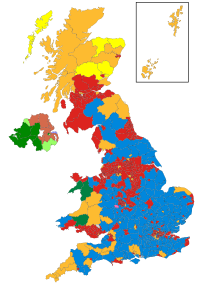| |||||||||||||||||||||||||||||||||||||||||||||||||||||
All 646 seats to the House of Commons 324[n 1] seats needed for a majority | |||||||||||||||||||||||||||||||||||||||||||||||||||||
|---|---|---|---|---|---|---|---|---|---|---|---|---|---|---|---|---|---|---|---|---|---|---|---|---|---|---|---|---|---|---|---|---|---|---|---|---|---|---|---|---|---|---|---|---|---|---|---|---|---|---|---|---|---|
| Opinion polls | |||||||||||||||||||||||||||||||||||||||||||||||||||||
| Registered | 44,245,939 | ||||||||||||||||||||||||||||||||||||||||||||||||||||
| Turnout | 27,148,510 61.4% ( | ||||||||||||||||||||||||||||||||||||||||||||||||||||
| |||||||||||||||||||||||||||||||||||||||||||||||||||||
 Colours denote the winning party, as shown in the main table of results. * Indicates boundary change – so this is a notional figure ‡ Figure does not include the Speaker, Michael Martin | |||||||||||||||||||||||||||||||||||||||||||||||||||||
 Composition of the House of Commons after the election | |||||||||||||||||||||||||||||||||||||||||||||||||||||
| |||||||||||||||||||||||||||||||||||||||||||||||||||||
The 2005 United Kingdom general election was held on Thursday 5 May 2005, to elect 646 members to the House of Commons. The governing Labour Party led by the prime minister Tony Blair won its third consecutive victory, with Blair becoming the second Labour leader after Harold Wilson to form three majority governments. However, its majority fell to 66 seats; the majority it won four years earlier had been of 167 seats. The UK media interpreted the results as an indicator of a breakdown in trust in the government, and especially in Blair.
This was the first time the Labour Party had won a third consecutive election, but would be the last election victory for Labour until 2024. The Liberal Democrats, led by Charles Kennedy, increased its seat count for a third consecutive election, netting the most seats in its history until 2024 and the most of any of the connected British Liberal parties since 1929. The Labour campaign emphasised a strong economy; however, Blair had suffered a decline in popularity, which was exacerbated by the controversial decision to send British troops to invade Iraq in 2003. Despite this, Labour mostly retained its leads over the Conservatives in opinion polls on economic competence and leadership, and Conservative leaders Iain Duncan Smith (2001–2003) and Michael Howard (2003–2005) struggled to capitalise on Blair's unpopularity, with the party consistently trailing behind Labour in the polls throughout the 2001–2005 parliament.[2] The Conservatives campaigned on policies such as immigration limits, improving poorly managed hospitals, and reducing high crime rates. The Liberal Democrats took a strong stance against the Iraq War, particularly due to the absence of a second United Nations resolution,[3] This anti-war position resonated with disenchanted Labour voters,[4] leading to the Liberal Democrats achieving what was at that point their largest vote share in their history.
Blair won a third term as prime minister, with Labour having 355 MPs, but with a popular vote share of just 35.2%. This was the smallest of any majority government in UK electoral history until Keir Starmer won an even lower share in 2024. In terms of votes, Labour was only narrowly ahead of the Conservatives, but the party still held a comfortable lead in terms of seats. The Conservatives returned 198 MPs, with 32 more seats than they had won at the previous general election, and won the popular vote in England, while still ending up with 91 fewer MPs in England than Labour. The Liberal Democrats saw their share of the popular vote increase by 3.7%, and won the most seats of any third party since 1923, with 62 MPs. Anti-war activist and former Labour MP George Galloway was elected as the MP for Bethnal Green and Bow under the Respect – The Unity Coalition banner, unseating Oona King; Richard Taylor was re-elected for Kidderminster Health Concern in Wyre Forest; and independent candidate Peter Law was elected in Blaenau Gwent.[5]
In Northern Ireland, the Ulster Unionist Party (UUP), the more moderate of the main unionist parties, which had dominated Northern Irish politics since the 1920s, was reduced from six MPs to one, with party leader David Trimble himself being unseated. The more hardline Democratic Unionist Party became the largest Northern Irish party, with nine MPs elected. Apart from Trimble, notable MPs leaving the House of Commons at this election included former SDLP leader John Hume, former Cabinet ministers Estelle Morris, Paul Boateng, Chris Smith, Gillian Shephard, Virginia Bottomley and Michael Portillo, the Father of the House of Commons Tam Dalyell, Tony Banks and Sir Teddy Taylor, while Stephen Twigg lost the Enfield Southgate constituency back to the Conservatives. A notable MP who joined the House of Commons at this election was future Labour leader and energy secretary Ed Miliband.
Following the election, Michael Howard conceded defeat, resigned as Conservative leader and was succeeded by future prime minister David Cameron. Blair resigned as both prime minister and leader of the Labour Party in June 2007, and was replaced by Gordon Brown, the then Chancellor of the Exchequer. The election results were broadcast live on the BBC and presented by Peter Snow, David Dimbleby, Tony King, Jeremy Paxman, and Andrew Marr.
- ^ "Government majority". Institute for Government. 20 December 2019.
- ^ "2001-2005 Polls". UK Polling Report. Archived from the original on 14 November 2021. Retrieved 14 November 2021.
- ^ "Blair is not the only one with Iraq amnesia – the Lib Dems were NOT anti-invasion, just anti-that-kind-of-invasion". UK: Left Foot Forward. 17 June 2014. Retrieved 26 March 2015.
- ^ Cowling, David (7 May 2005). "Who deserted Labour?". BBC News. Retrieved 14 November 2021.
- ^ "The 2005 General Election: Worst Election Ever". www.electoral-reform.org.uk. Retrieved 1 April 2023.
Cite error: There are <ref group=n> tags on this page, but the references will not show without a {{reflist|group=n}} template (see the help page).


